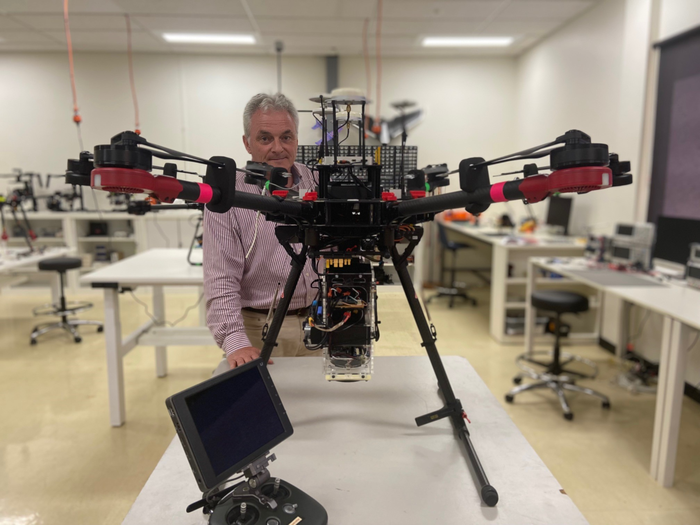Australian scientists have used reverse engineering, for the first time, on the visual systems of hoverflies to sense the acoustic signatures of drones from nearly 4 km away.
 UniSA Professor Anthony Finn pictured with A DJI Matrice 600 drone with a payload capable of emitting or receiving acoustic signals. Image Credit: University of South Australia
UniSA Professor Anthony Finn pictured with A DJI Matrice 600 drone with a payload capable of emitting or receiving acoustic signals. Image Credit: University of South Australia
Experts on autonomous systems from the University of South Australia (UniSA), Flinders University, and Midspar Systems, a defense company, report that experiments using bio-stimulated signal processing methods deliver a 50% improved detection rate compared to existing approaches.
The results, which could help fight the increasing worldwide danger posed by IED-carrying drones, including in Ukraine, have been published in The Journal of the Acoustical Society of America.
Anthony Finn, UniSA Professor of Autonomous Systems, says that vision systems of insects have been charted for a while now to enhance camera-based detections. However, this is the first study where bio-vision has been applied to acoustic data.
“Bio-vision processing has been shown to greatly increase the detection range of drones in both visual and infrared data. However, we have now shown we can pick up clear and crisp acoustic signatures of drones, including very small and quiet ones, using an algorithm based on the hoverfly’s visual system,” Prof Finn states.
The excellent visual and tracking abilities of the hoverfly have been productively modeled to spot drones in complex, busy and unknown landscapes, both for military and civilian purposes.
Unauthorised drones pose distinctive threats to airports, individuals, and military bases. It is therefore becoming ever-more critical for us to be able to detect specific locations of drones at long distances, using techniques that can pick up even the weakest signals. Our trials using the hoverfly-based algorithms show we can now do this.
Anthony Finn, Professor of Autonomous Systems, UniSA
Dr. Russell Brinkworth, an associate professor in autonomous systems at Flinders University, states the skill to see as well as hear small drones at greater distances could be immensely advantageous for safety authorities, aviation regulators and the wider public looking to track the ever-growing numbers of autonomous aircraft in sensitive airspace.
We’ve witnessed drones entering airspace where commercial airlines are landing and taking off in recent years, so developing the capacity to actually monitor small drones when they’re active near our airports or in our skies could be extremely beneficial towards improving safety.
Dr. Russell Brinkworth, Associate Professor in Autonomous Systems, Flinders University
“The impact of UAVs in modern warfare is also becoming evident during the war in Ukraine, so keeping on top of their location is actually in the national interest. Our research aims to extend the detection range considerably as the use of drones increases in the civilian and military space,” Dr. Brinkworth added.
In comparison with traditional methods, bio-stimulated processing enhanced detection ranges from 30 to 49%, based on the kind of drone and the surroundings.
Scientists seek precise patterns (narrowband) and/or standard signals (broadband) to detect drone acoustics at short-to-medium distances, but at a greater distance, the signal is feebler and both methods struggle to accomplish dependable results.
Similar circumstances are present in the natural world. Dark lit areas are extremely noisy but insects like the hoverfly possess a very strong visual system that can pick up visual signals, scientists state.
We worked under the assumption that the same processes which allow small visual targets to be seen amongst visual clutter could be redeployed to extract low volume acoustic signatures from drones buried in noise.
Dr. Russell Brinkworth, Associate Professor in Autonomous Systems, Flinders University
By changing acoustic signals into two-dimensional (2D) “images” (known as spectrograms), scientists used the hoverfly brain’s neural pathway to enhance and overpower unconnected noise and signals, expanding the detection range for the sounds they desired to detect.
Putting together their image-processing abilities and sensing proficiency, the researchers made this bio-stimulated acoustic data innovation.
This study was made possible through Federal Government funding via the Department of Defense’s Next Generation Technologies Fund. The funding supports, in part, technological solutions to tackle the weaponization of drones which are currently among the deadliest arms in contemporary warfare, killing or wounding over 3,000 enemy soldiers in Afghanistan and being used in the present war in Ukraine.
Hoverfly brains mapped to detect drones’ acoustic signals
Video Credit: University of South Australia.
Journal Reference:
Fang, J., et al. (2022) Acoustic detection of unmanned aerial vehicles using biologically inspired vision processing. The Journal of the Acoustical Society of America. doi.org/10.1121/10.0009350.